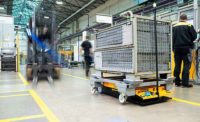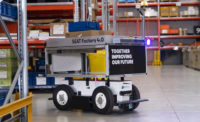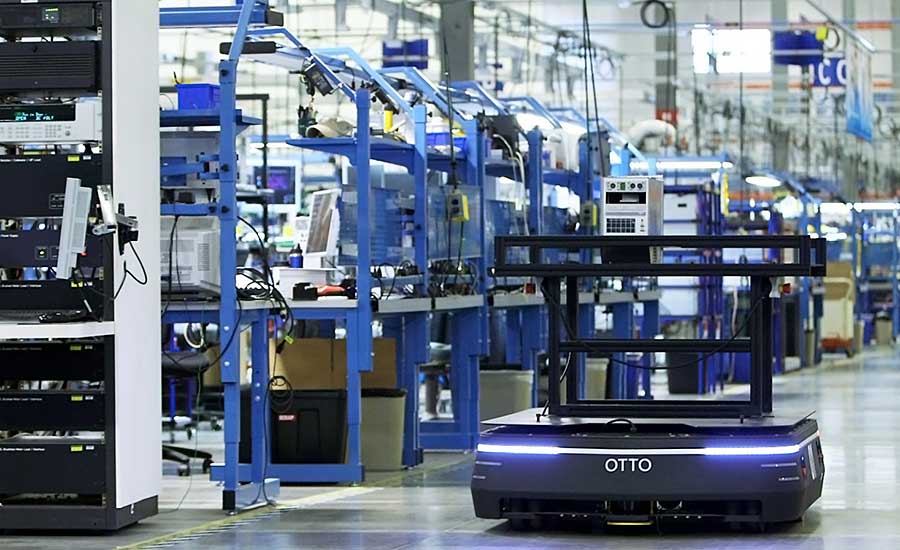GE Healthcare Achieves Lean Efficiency With Autonomous Mobile Robots

At its mega facility in West Milwaukee, WI, GE Healthcare repairs and remanufactures all types of imaging, diagnostic and patient monitoring equipment. Photo courtesy OTTO Motors

OTTO robots bring parts to be repaired to workers and take finished parts to the shipping area. Photo courtesy OTTO Motors


‘Nothing lasts forever’ is an expression, and a reality, that manufacturers of all sizes know all too well. When a product stops working—for whatever reason—the end-user must either repair it or replace it. For a large company like GE Healthcare (GEH), repairing its medical equipment enables hospitals to simultaneously save money, maintain operations and provide the best possible patient care.
Several years ago, GEH consolidated multiple U.S.-based repair operations into a 280,000-square-foot facility in West Milwaukee, WI. Managers there rely on lean and advanced manufacturing, 3D printing and software analytics to quickly repair and remanufacture all types of imaging, diagnostic and patient monitoring equipment.
The mega center is ISO 13485 and 14001 certified, and fully aligned with the company’s GE Brilliant Factory platform, which emphasizes four pillars: automation, novel process prototyping, informatics and model-based manufacturing. Equally important, notes Joe Germait, group lead at GE Healthcare, is optimizing efficiency of all operations.
Prior to site consolidation, technicians at each repair center pushed carts to move equipment between repair cells, the shipping area and other technicians. This manual process often resulted in inefficient material flow, according to Germait.
In addition, finished repairs would be added to other types of equipment on the nearest cart before proceeding to shipping. The problem with this was the finished repairs often sat on the cart for an extended time prior to reaching the shipping department.
Additionally, bulky carts and fixed infrastructure limited throughput by reducing the amount of available floor space for productive repair cells. To overcome these problems, GEH began using several autonomous mobile robots (AMR) made by OTTO Motors.
“OTTO [AMRs] makes our jobs easier,” says Germait. “Space is [limited] in our work areas, so it’s helpful that we call an OTTO on demand and have it come pick up our parts. The pickup times are short, allowing us to switch to the next part more quickly. Occasionally, we meet up with an AMR in the aisle-ways, and it goes right around us.”
Germain likes the OTTOs because they get material where it needs to be, when it needs to be there. This is essential, as the AMRs must deliver parts for more than 2,000 equipment repairs per week.
Material flow efficiency is improved, notes Germait, because the robots enable pull-type supply chain management, where material movement is based on actual demand. However, material handling is not standardized because the facility receives different-size parts every day, and the parts often need to be delivered to different repair cells.
Worker productivity is also better, according to Germait. After a technician finishes repairing a part, he or she calls for an AMR, which, in turn, brings a part to be repaired and takes a finished part to shipping.
Because OTTO is autonomous, it requires neither a magnetic strip nor a conveyor to move. The AMR is also ‘smart’ enough to arbitrarily decide on the best route, since the material flow process can change depending on what parts come in for repair.
Hundreds of technicians work in the West Milwaukee facility, in repair cells that are 40 percent smaller since implementing AMRs. Downsizing the cells has also enabled GEH to increase its productive floor space by 66 percent and greatly improve throughput per square foot.
“We can analyze the habits of our employees with the data provided by the OTTOs,” concludes Kyle Smith, business team leader for refurbishment and harvest at GEHe. “This is the kind of vital information we need to help improve our operations [and] deliver repairs as quickly as possible.”
For more information on AMRs, call 844-733-6886 or visit https://ottomotors.com.
Looking for a reprint of this article?
From high-res PDFs to custom plaques, order your copy today!








